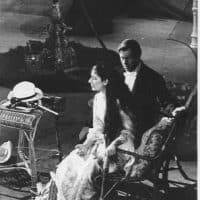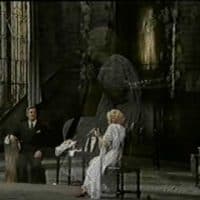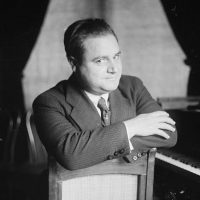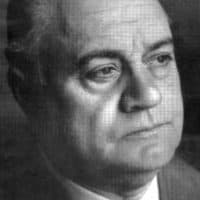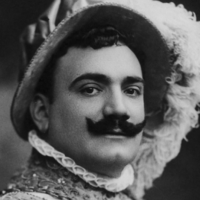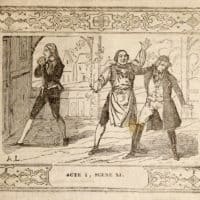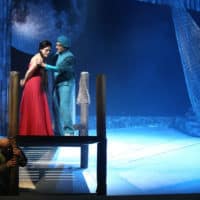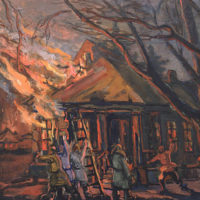Quality certainly isn’t the only criterion that decides whether a work of art survives or not: luck and a few other rather aleatory factors seem to play a major role. In today’s standard repertoires we can find works that should not have survived the decade in which they were written. Those are works that are known for one or two clever melodic idea while the rest lacks invention and substance. Then, on the other hand, there are works that are of high musical quality throughout that fell from grace from the very beginning or just enjoyed short waves of popularity or a renaissance – just to be ignored and forgotten for good. Granted, operatic literature is full of works that were rightly forgotten simply for their lack of musical substance. This focus feature, however, presents five operas that are worth re-discovering.
Pietro Mascagni: Silvano
Opera in two acts
Libretto: Giovanni Targioni-Tozzetti
First performance: Teatro alla Scala, March 25, 1895
Conductor: Rodolfo Ferrari
Cast:
Matilde, s – Adele Stehle
Silvano, t – Fernando de Lucia
Renzo, br – Giuseppe Pacini
Rosa, ms – Leonilde Ponzano
In his late 30s, Mascagni was a real workhorse. Between 1890 and 1895 he composed five operas of which Cavalleria Rusticana (1890), L’Amico Fritz (1891) and Guglielmo Ratcliff (1895) stand out for the excellent composition and sheer abundance of musical invention. Silvano was premiered in 1895 and is another “plebeian” drama, a popular genre in operatic Europe of those years. Set at the Adriatic coast in central Italy, the plot revolves around the rivalry of two fishermen who are in love with the same woman. True to Western operatic tradition, Silvano, the young man winning Matilde’s heart, is a tenor. His rival, Renzo, a bass-baritone. The drama climaxes in a duel of the two men which ends, ultimately, with Renzo’s death.
Silvano comes in two acts and is a rather short composition that does not last more than 70-80 minutes. The opera is somewhat “semi through-composed”, meaning that there is a continuous flow of music without recitatives, albeit with clear cues that signal the audience where to interrupt. In his later operas, Mascagni abandoned that structure in favor of a more through-composed, closed concept. The style and orchestration are as unmistakably Mascagnian as the melodic genius displayed throughout the opera. Matilde’s opening aria (“Forse domani al colpo delle allegre campane”) is a lyric, melancholic starter that sets the tone for the rest of the 80 minutes. The following love duet between Matilde and Silvano is one of Mascagni’s great duets, comparable to the famous cherry duet from L’Amico Fritz. Silvano’s furious arioso in his first confrontation with his rival Renzo is a brilliant and dramatic showpiece for any capable robusto. The same goes for Silvano’s long scene in the second act which combines great lyric legato lines with dramatic climaxes and which is one of the most beautiful pieces ever penned down by Mascagni (“Come le barche… Si è spento il sole”). As usual, Mascagni added a few catchy instrumental tunes of which the act 2 barcarole stands out. The latter came to a certain fame after being used by Martin Scorsese in his film Raging Bull. It is certainly safe to say though that Scorsese’s film was seen by far more people than Mascagni’s opera.
There might be two reasons for why Silvano has disappeared from the programs. Some might argue that is too long for a double bill and too short on its own. Another reason is the title role: Silvano is a tenor’s opera and needs a musical robusto tenor with solid acuti, able to sing for 20 minutes straight and able to play on the full scale from lyric to dramatic and back.
There are currently five recordings available (four live, one studio) of which the 1973 recording (RAI, with Gianni Jaia in the title role) and the 1980 recording (Teatro Goldoni Livorno, Angelo Mori) are the best.
AUDIO: S’è spento il sole (Silvano’s act two aria) – Tenor: Angelo Mori
FURTHER READING
http://www.gbopera.it/2013/12/mascagni-100silvano/ (in Italian)
ABOUT ANGELO MORI
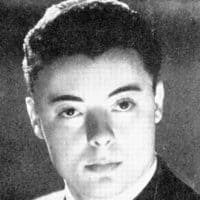 Undoubtedly one of the most talented and gifted Italian post-war tenors, Mori studied with Marcello del Monaco and made his debut in 1962. He sang practically in all major Italian houses but was neglected a real international career, ignored by the leading agencies. Mori had rare, true spinto material: a bright, well balanced voice with homogenous registers, elegance, great power and an impeccable technique. The recording of Silvano proves this point as he excels in a part that asks for almost endless resources. Mori left few commercial recordings, most of the material available are live recordings.
Undoubtedly one of the most talented and gifted Italian post-war tenors, Mori studied with Marcello del Monaco and made his debut in 1962. He sang practically in all major Italian houses but was neglected a real international career, ignored by the leading agencies. Mori had rare, true spinto material: a bright, well balanced voice with homogenous registers, elegance, great power and an impeccable technique. The recording of Silvano proves this point as he excels in a part that asks for almost endless resources. Mori left few commercial recordings, most of the material available are live recordings.
Franco Leoni: L’Oracolo
Opera in one act
Libretto: Camillo Zanoni
First performance: Covent Garden, July 3, 1905
Conductor: André Messager
Cast:
Cim-Fen, br – Antonio Scotti
Ah-Joe, s – Pauline Donalda
Uin-San-Lui, t – Charles Dalmorès
Uin-Sci, bs – Vanni Marcoux
Around 1900 and the following two decades, plots set in foreign cultures were very popular among Italian opera composers. There are dramas taking place in rural Scotland, czarist Russia, Scandinavia, the US, Japan and China among others. Leoni’s L’Oracolo however, takes the cake: this drama of love, jealousy, abduction, crime, drugs and murder takes place in a Chinese quarter in San Francisco. The constellation is the same as in Silvano: Uin-San-Lui (tenor) and Cim-Fen (opium-dealer, villain and baritone) both love Ah-Joe (soprano). As Ah-Joe expresses her love for Uin-San-Lui, Cim-Fen devises a scheme. Ah-Joe’s uncle is father to a little boy. Cim-Fen abducts the child and hides it in his cellar. As the search for the child is unsuccessful, Cim-Fen offers to find the child if he gets Ah-Joe in return. Uin-San-Lui sees through the plot and finds the child. As he tries to rescue it, Cim-Fen kills him and throws the child into a trash-can on the street. Upon the news of Uin-San-Lui’s death, Ah-Joe loses her mind.
Leoni’s score overflows with originality despite being a pure tonal work. The opera’s first bars are stunning: the timpani strike three times, followed by two cock crows. Then, some men sing in fake Chinese (“Wufet! Tan-hae! Fulu! Sam-ciau!”), followed by an unaccompanied solo by Cim-Fen. The rest of the through-composed piece is just as innovative and packed with beautiful and dense melodic invention. Many melodies, such as the chorus of the men in Cim-Fen’s opium den or Uin-San-Lui’s leitmotiv are so catchy that they “stick” immediately. The orchestration is another feat: very colorful, diversified and original throughout and certainly better than in many operas of much greater fame.
L’Oracolo only has one act and is rather short (~60 minutes). After a successful decade with performances in London and at the Met with Antonio Scotti as Cim-Fen, the work somehow disappeared. There is no reason not to put this wonderful opera into a double bill with another more famous opera. Pair it with some Puccini, Cavalleria Rusticana or Pagliacci, and the house will be full nonetheless.
There are three recordings, one studio and two live. The studio recording (Decca 1975, with Gobbi as Cim-Fen) is the best choice, the live recordings (1969, amateur performance with piano accompaniment, and 2009, Oper Frankfurt, Germany) are no match for Gobbi’s characterization of the opium dealer and Decca’s outstanding sound engineering.
AUDIO: Opening scene; Baritone: Tito Gobbi
FURTHER READING
http://www.jmucci.com/opera/operamusic/leoniapprec.htm
http://www.progettobabele.it/rubriche/SHOWRAC.PHP?ID=3064 (in Italian)
ABOUT TITO GOBBI
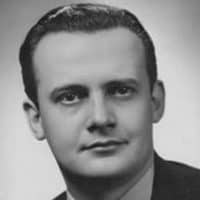 Nothing much needs to be said about this mostro sacro of Italian opera. After his studies with Giulio Crimi, he made his debut in 1935 and became one of the most sought after baritones until his retirement in 1979. He is widely considered to be one of the best Scarpias and Iagos of all time. His singing though was far from flawless, and he himself used to admit to technical issues, especially a hollow sounding, stiff upper register. Gobbi, though, made up for those flaws with outstanding vocal acting. While his sometimes acrid sound was perfect for certain villains, he wasn’t the perfect cast for roles that required a more noble sound, such as Conte di Luna or Renato.
Nothing much needs to be said about this mostro sacro of Italian opera. After his studies with Giulio Crimi, he made his debut in 1935 and became one of the most sought after baritones until his retirement in 1979. He is widely considered to be one of the best Scarpias and Iagos of all time. His singing though was far from flawless, and he himself used to admit to technical issues, especially a hollow sounding, stiff upper register. Gobbi, though, made up for those flaws with outstanding vocal acting. While his sometimes acrid sound was perfect for certain villains, he wasn’t the perfect cast for roles that required a more noble sound, such as Conte di Luna or Renato.
Zoltán Kodály: Székely Fonó
Lyrical play in one act
Libretto: Zoltán Kodály, based on traditional folk tales
First performance: Budapest, April 24, 1932
Conductor: Sergio Failoni
Cast:
Kérője, br – Imre Palló
Háziasszony, a – Mária Basilides
Fiatal legény, t – Endre Rösler
Fiatal leány, s – Anna Báthy
This work by Béla Bartók’s teacher Zoltán Kodály is not strictly an opera as it contains pantomime and folk dance, and its text consists of nothing but folk texts. Its music is based on Hungarian folk music. Kodály, however, managed to bind all those elements together in a stunning fashion: it bares the composer’s handwriting from the very beginning and appears in such a closed, through-composed shape that it indeed seems an opera inspired by folk music. The drama is simple: a woman bids her lover farewell. He must escape as he is accused of a crime he hasn’t committed, but he is unable to prove his innocence. This, as most other scenes, takes place in a spinning room (székely fonó), and is followed by atmospheric portrayals of folk life in the Transylvanian village where the plot takes place. In the end, the lover manages to prove his innocence and returns.
Of all works presented here, Székely Fonó might be the one with the greatest melodic abundance. The opening duet of the lover and the woman (“Elmenyek, elmenyek”) is among the most beautiful music ever written for the human voice. Another extraordinary number is the duet of a young girl and her lover in scene 6 (“A csitári hegyek”), even though it seems unfair to highlight certain scenes as the musical quality is very high throughout the entire work. The mystical, dark and melancholic sound of the Hungarian folk music, its homophonic and pentatonic character and the language (where always the first syllabus is stressed) adds some truly exotic spice.
“…strong, broadly sweeping melodic invention, a perfect grasp of form… not modern in the general sense of the word… for him, everything is based on evenly based tonality. Still, his musical idiom is completely new and expresses thoughts never heard before which proves that the principle of tonality is not yet fully exhausted.” (Béla Bartók on Székely Fonó)
One of the reasons for why Székely Fonó is not performed more often might be its length: about 80 minutes and like Silvano too long for a double bill and too short on its own (even though the work was premiered in a double bill). Other than that, there is no reason for keeping this wonderful piece off the major stages.
There is only one recording of this work, made by Hungaroton in 1970. Fortunately, it is a good one.
AUDIO: Elmenyek, elmenyek; Baritone: György Melis; Alto: Erszébet Komlóssy
ABOUT THE SINGERS
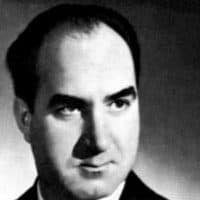 György Melis was the Hungarian baritone during the 1960s and 1970s. In Hungary, he sang most of the major dramatic baritone roles. He had a velvety, warm voice, his vocality though was very much affected by his native language: his sound was a genuinely Hungarian sound, no matter which language he sang in. Melis is one of the best Bluebeards on record.
György Melis was the Hungarian baritone during the 1960s and 1970s. In Hungary, he sang most of the major dramatic baritone roles. He had a velvety, warm voice, his vocality though was very much affected by his native language: his sound was a genuinely Hungarian sound, no matter which language he sang in. Melis is one of the best Bluebeards on record.
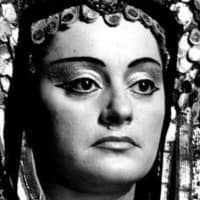 Erszébet Komlóssy was similar to Melis, one of the principal figures on Hungarian stages during the 60s and 70s. She excelled in Hungarian repertoire as well as a Verdi-mezzo and a Carmen of international fame.
Erszébet Komlóssy was similar to Melis, one of the principal figures on Hungarian stages during the 60s and 70s. She excelled in Hungarian repertoire as well as a Verdi-mezzo and a Carmen of international fame.
Arrigo Boito: Nerone
Opera in four acts
Libretto: Arrigo Boito
First performance: Teatro alla Scala, May 1, 1924
Conductor: Arturo Toscanini
Cast: Nerone, t – Aureliano Pertile
Fanuél, br – Carlo Galeffi
Simon Mago, bs – Marcel Journet
Asteria, s – Rosa Raisa
Imagine MGM’s monumental Quo vadis set to music – and you have Nerone. This work by Boito has it all: a neurotic emperor Nero, his fawning and scheming courtiers, Via Appia, Circus Maximus, Christians, mass scenes and massacres, and, ultimately, a devastating fire. Above all though, there is Boito’s wonderful music. Boito, tormented by his legendary perfectionism, had left the instrumentation of the last act unfinished when he passed away. The instrumentation was completed by Vincenzo Tommasini and Arturo Toscanini, and the first performance of the monumental work took place at La Scala in 1924 – unter Toscanini’s baton, with Pertile in the title role and a luxury cast consisting of Raisa, Galeffi, Journet and Pinza. Despite great critical acclaim, the work disappeared as soon as Toscanini stopped conducting it.
From a musical point of view, it is difficult to understand why Boito’s other opera Mefistofele is so much better known than Nerone. Nerone is less cumbersome than Mefistofele, easily accessible through greater melodic richness and effective arias, duets and ensemble scenes. Also, Boito managed to create somewhat of a “Roman sound” or a sound like what we imagine Rome might have sounded like. As it is the case with the MGM movies of the 1950s and 1960s, it is of course pure fantasy, especially when compared to the few fragments of Roman music that have survived. But this is not a quest for historic accuracy. This is all about atmosphere, and this is where Boito did not only create something new but also hit the mark – some 40 years before Rósza & co.
The reason why this work is ignored by the major opera houses is probably its monumental scale. It asks for nothing less than 22 soloists, a huge chorus and orchestra plus a movie-like staging. The leads are difficult: the tenor needs to be a robusto – Pertile must have been the perfect cast for the role. The baritone role (Fanuèl, the Christian leader) and the bass (Simon Mago, a magician) are parts with a very high and tiring tessitura. The San Carlo in Naples revived the piece in 1957. RAI performed it in 1975. Despite the enormous requirements to soloists and stage: I’d rather hear a Nerone with a somewhat reduced stage (modern directors should not have a problem with that) instead of yet another of the umpteen mediocre Bohèmes that litter our days’ programs.
There are a handful of recordings, among others three 78rpm sides with excerpts with Galeffi and Journet, made in 1924, and excerpts of a live performance conducted by Toscanini in 1948. As to complete recordings, there is one studio version (1981 under Queler) and two live ones (San Carlo di Napoli 1957 and RAI 1975). Out of those, the 1957 is the best version, featuring a superb Mirto Picchi in the title role, as well as Giangiacomo Guelfi as Fanuél and Mario Petri as Simon Mago. The 1975 recording is superior in sound quality, but bass Agostino Ferrin (Simon Mago) had an off night, omitting all the high notes.
AUDIO: Beata Roma che t’ode -Tenor: Bruno Prevedi
FURTHER READING
http://www.angelfire.com/nv2/himeji/NERONE.htm
http://dante.di.unipi.it/ricerca/libretti/neroneb.html (Libretto)
http://www.soyombo.it/arrigoboito/nerone.htm (in Italian)
ABOUT THE SINGER
 Bruno Prevedi was one of the better Italian B-tenors during the 1960s and 70s, capable of coping with the most difficult Verdi repertoire without getting into too much trouble. The reason why he never arose to great international fame was most probably the fact that his voice lacked charisma, at least when compared to Del Monaco, Di Stefano, Corelli and later Bergonzi and so on. At times, he tended to “over-cover”, which effectively robbed the voice of excitement.
Bruno Prevedi was one of the better Italian B-tenors during the 1960s and 70s, capable of coping with the most difficult Verdi repertoire without getting into too much trouble. The reason why he never arose to great international fame was most probably the fact that his voice lacked charisma, at least when compared to Del Monaco, Di Stefano, Corelli and later Bergonzi and so on. At times, he tended to “over-cover”, which effectively robbed the voice of excitement.
Mario Castelnuovo-Tedesco: L’Importanza di esser Franco (aka L’Importanza di chiamarsi Ernesto)
Opera in three acts
Libretto: Mario Castelnuovo-Tedesco
First performance: RAI, November 13, 1962
Conductor: Angelo Campori
Cast: John Worthing, t – Alvinio Misciano
Algernon Moncrieff, t – Florindo Andreolli
Gwendolin Fairfax, s – Edda Vincenzi
Lady Bracknell, ms – Laura Zanini
This opera will hardly ever become a repertoire piece, and it does not have to. However, it is more than worth rediscovering, especially if you are knowledgeable about opera and classical music in general. Nothing much needs to be said about the drama, the libretto is closely modeled after Oscar Wilde’s The Importance of being Ernest, but what is so special about the music?
On the one hand, Castelnuovo-Tedesco managed to pinpoint the ironic, witty and elegant tone of Wilde’s play in music. It certainly is extremely difficult to be funny in music, but Castelnuovo-Tedesco excels in it. Though strictly tonal, this is a modern piece of music which does not follow the “traditional Italian way” of composing opera: there are no arias, showstoppers and excessive high notes to be heard. Instead, there are a few spoken words here and there – a reminder that it is a play by Oscar Wilde where the words need to be respected. Listening to the text is very entertaining – even more so is the music: it consists almost entirely of musical quotes from other operas and other classical works from Mozart to Wagner and Verdi. This piece is 2 hours of patchwork, but so masterfully put together that is a true delight to listen to. Every few seconds, there is a surprise, and one remains nothing but amazed at how well the quotes are merged.
Often, the musical quotes only play in the orchestra, which by the way only consists of two grand pianos and percussion. Nonetheless, the concept works. This piece is surprisingly pleasant to listen to and highly entertaining. And a composer who steals most of his material for an opera entitled The Importance of being Ernest is of course funny and, possibly, could be read as a critique towards his profession.
There is one recording of this rare piece, luckily, it is a recording of the first performance.
AUDIO: Potrei di certo, nipote (act 3) – Misciano, Vincenzi, Andreolli
ABOUT THE SINGERS
 Out of the bunch of RAI “staple”-singers, Misciano is the one that stands out – first because of his very distinct timbre, and secondly because of the 1960 Tosca-movie in which he sang the role of Cavaradossi alongside Magda Olivero. Being a leggero tenor, Cavaradossi was way too heavy for him, but in lighter roles such as Almaviva, he was truly excellent, except maybe for the pushy upper register “à la Tagliavini”.
Out of the bunch of RAI “staple”-singers, Misciano is the one that stands out – first because of his very distinct timbre, and secondly because of the 1960 Tosca-movie in which he sang the role of Cavaradossi alongside Magda Olivero. Being a leggero tenor, Cavaradossi was way too heavy for him, but in lighter roles such as Almaviva, he was truly excellent, except maybe for the pushy upper register “à la Tagliavini”.
